
robert rattray : padua, lake botsumtwi, africa, 1921
| home | catalogue | history | references | appendix |
 |
surfresearch.com.au
robert rattray : padua, lake botsumtwi, africa, 1921 |
The padua
of Lake Botsumtwi is a remarkable instance of an ancient
design of water-caft enduring in a remote jungle
location as a result of the natives rigorously enforcing local
taboos.
The story could
be a chapter from Arthur Conan Doyle's The Lost World
(1914).
More
prosaically?, less exotically? less romantically? , the padua
encapsulates James Hornell's theory of the development of
ancient water-craft - it is virtually a "missing-link."
In Water
Transport- Origins and Early Evolution (1946), Hornell
proposed that the first water-craft was the "swimming or
riding float" (hereafter, the float board), which facilitated
the development of swimming and was the basis for the next
technological advance, the raft.
He further
suggested that the float board itself continued to evolve,
reaching its highest level of sophistication as the Hawaiian
surfboard.
Lake Botsumtwi
is formed in the basin of of meteorite impact crater, 10.5 km
in diameter, and estimated to be 1.07 million years old.
While the
bottom of the lake has gradually risen with the deposition of
eroded sediment from the crater walls, its catchment is
limited to rain falling directly within the crater's rim.
As the climate
has fluctuated over millennia, the lake's size has varied
markedly, on occasion rising above the lowest points of the
rim and, at the other extreme, reducing to a small pond.
When Robert
Rattray visited the lake in 1921 there were 26 villages, but
he was told of another four that had recently been submerged
He confirmed
that had been an increase in the level of the lake, evidenced
by a number of surviving tree stumps.
This is well
illustrated in Rattaray's photographs, which are a valuable
adjunct to the text.
Recognised as
a special place of religious significance, severe limitations
were placed on the technology employed by the native fisherman
on Lake Botsumtwi, retaining a Neolithic culture despite far
more advanced technology being readily available.
A firmly
established religious belief, in practice it also probably
served, to some degree, to manage the fish stock.
Only swimming
and paddling on float boards, the padua, are permitted
on the lake.
When swimming,
they use "either the ordinary breast stroke or a double
overarm with a scissor-like kick of the legs," the latter
directly associated with an established familiarity of
propelling float boards.
The padua
are rough hewn from logs of a light wood, "almost as soft
as cork."
Rattray gives
the botanical name as Musanga Smithii, which has since
been reclassified as Musanga cecropioides.
This fast
growing, but short-lived, tree has a straight trunk, up to19
inches or 0.5 metre in diameter, and reaches heights of 60-150
feet or 18-45 metres.
It features an
umbrella-shaped crown and is dioecious, a feature
common to primitive species
Reported as
rare in the tropical jungle, forest swamps and along rivers,
it is not immediately apparent if the fisherman of Lake
Botsumtwi obtained this timber from the shores of the lake or
from outside the crater.
Unfortunately,
Rattray does not provide an account on where or how the
corkwood trees where harvested, or how the padua was
constructed.
Given the the religious significance of the lake, this may
have had associated ceremonies or incurred some restrictions,
such as the use of metal tools.
Note that the padua
builders, like many boa t-builders, construct
replicas of their craft, and a small model padua presented
to Rattray is shown in Fig. 13.
The padua are
6
in. to 8 in. thick, about a foot wide, range in length
from 6 to 10 feet, and the template is trimmed at the nose
and the tail.
As Dawson
notes, the padua resemble (some of) the
surfboards of ancient Hawaii.
In particular, there are a number of features similar to the olo-
a "thick" and "narrow" board that was 5 to 8 inches deep,
usually less than 15 inches wide, and made from light-weight willi
willi.
The olo was
reported
to be built up to extreme lengths for the surf riding chiefs,
reliably up to about 16 feet, and was ridden prone.
While its forte
was undoubtedly as a paddle board, its wave riding performance
was improved with its high dome deck and bevelled rails.
Like the padua,
the olo was likely to be cut from an individual tree
trunk, unlike the most common board in Polynesia, the alaia.
A wide and thin
board, the alaia was shaped from plank (or
billet) of koa, one of several previously split
in sections from a log.
Rattray's
photographs show a range of dimensions and design features;
some have a square box-rail and some have rocker, where the
"ends stood out of the water higher than the centre."
As with all
one-piece timber craft, some of these elements were probably
determined by qualities of the harvested tree.
The padua
is propelled in the standard prone paddling manner,
Rattray noting that "perfect steering control is obtained by a
flick of the foot upon the surface of the water.'
IHe notes
that the padua is propelled along the surface of
the water much faster than an ordinary canoe is paddled or
poled by one man, " and Fig. 13 certainly shows two young
riders leaving a significant wake as they paddle away from the
camera.
The photographs
in Fig. 9 and 10 show the padua riders astride their
boards with confidence and a relaxed demeanour, reminiscent of
photographs of groups of surfboard riders waiting for
set-waves outside of the surf zone.
R. S. Rattray identifies four simple types of nets used on the lake made from strips of a local reed, and an "even more" primitive method called abontuo, where the fisherman dives for fish on bottom, returning to the surface hands free and holding the catch with their teeth, page 66..
When goods or
passengers required transportation, several padua are
tied together to form a raft, a mpata.
As illustrated
in Figs. 13 and 14, the mpata is either shunted,
with the nose of the padua or the rider's foot held
against the stern, or towed with a line of creeper
usually tied around the rider's ankle, or a combination of
both.
Surfboard
riders would recognise the similarity of the tow-line to the
modern safety accessory, the leg-rope or leash.
If the padua
and the skills of their riders were transposed back in time to
the coast of West Africa, it may suggest how these simple
craft could fully provide the transport and fishing needs of
early coastal dwellers.
They would have
also been particularly effective in the surf zone and highly
suitable as surfboards.
In light of this study of the water-craft of the fishermen of Lake Botsumtwi, Hornell's thesis may be slightly refined.
The first
watercraft, the float board (padua) had an extended
period of use, which facilitated the development of swimming.
Long-term
familiarity with the float board presented the possibility of
a composite craft, the raft (mpata).
Initially, the
raft did not require the use of the pole for propulsion,
although this would surely have been quickly adopted in
shallow waters.
The dugout
canoe was a significantly later development, requiring a far
more sophisitcated technology, and which only became highly
effective in deep water with the development of the paddle, or
the bladed pole.
A simple paddle
was probably first used to propel small rafts, as exemplified
by the catamaran riders of Madras on the coast of
India, as were likely the first experiments with sails.
There are
currently about 30 villages in the vicinity of Lake Botsumtwi
with a combined population of about 70,000 people, placing
considerable stress on the local environment..
Largely now
noted as a tourist resort, the traditional fishing methods
using the padua are still in practice as of 2013.
References
1. James Hornell : Water Transport-
Origins and Early Evolution.
Cambridge
University Press, Cambridge,1946.
2. Dawson,
Kevin
: Swimming, Surfing and Underwater Diving in Early Modern
Atlantic Africa and the African Diaspora.
Carina Ray and
Jeremy Rich, eds., Navigating African Maritime History
Research in
Maritime History book series,
Memorial
University of Newfoundland Press, 2009, pages 81-116.
http://history.unlv.edu/faculty/dawson/Swimming
&
Surfing in Africa copy.pdf, viewed 10 April 2013.
Dawson notes on page 104:
"branch or
miscellaneous plank from a Western ship served the purpose.
Paddleboards
were buoyant enough to carry both their paddlers and small
cargoes.
Most likely
these boards were the prototype for Atlantic African
surfboards. (59)
While at
Elmina in the 1640s, Michael Hemmersam wrote that two canoemen
used a plank as an impromptu paddle-board.
When these
Africans went below Ambtsforth’s deck, 'their canoes drifted
away; so, without being at all afraid of drowning they laid
themselves on a board thrown out to them be the skipper and
swam ashore with it.
We were all
quite amazed at this great feat of daring.' (60)
When Robert
Rattray visited Lake Bosumtwi, he described and photographed
mpadua that probably closely resembled early Gold
Coast
surfboards.
“The ends of
some padua are cut away at both extremities so as to offer
less resistance than a blunt prow, and a few were seen in
which these
ends stood out of the water higher than the center,” wrote
Rattray.
Indeed, mpadua
are surprisingly similar to ancient Hawaiian surfboards and
even modern longboards. (61)
(Footnotes)
59. Finney,
'Surfboarding in West Africa,' 42; Jones (ed.),German Sources
103 and 109, and Hair, et al. (eds.), Barbot on Guinea, II,
532.
60. Quoted in
Jones (ed.),German Sources, 103.
61. Rattray,
Ashanti, 60-65. (page 104)"
These
references are:
Finney,
“Surfboarding in West Africa,”
Jones, ed., German Sources for West African History 1599-1699, Wiesbaden, 1983?
Paul Edward
Hedley Hair, Adam Jones, Robin Law (eds.):
Barbot on
Guinea:- the writings of Jean Barbot on West Africa
1678-1712, Hakluyt Society, 1992
Google
Books
http://books.google.com.au/books/about/Barbot_on_Guinea.html
Barbot reports
Page 532
[At ?,
circa 1712]
...
misfortune, with little or no concern, but this must proceed
from them being brought up, both men and women, from their
infancy, to swim like fishes; and that, with the constant
exercise, renders them so dexterous at it, tho' the canoo be
overturn'd or split to pieces they can either turn it up
again in the first case, [or] ...
... may be seen several hundred of boys and girls sporting together before the beach, and in many places amoung the rolling and breaking waves, learning to swim on bits of boards, or small bundles of rushes, fasten'd under their stomachs, which is a good diversion to the spectators. (50)
3.
Wikipedia: Lake Bosumtwi
http://en.wikipedia.org/wiki/Lake_Bosumtwi,
viewed
11 May 2013.
"There is a
traditional taboo against touching the water (at Lake
Bosumtwi) with iron and modern boats are not considered
appropriate.
The padua, a
wooden plank requiring considerable skill to maneuver, is the
legitimate method.
4. Virtual
Tourist
http://cdn3.vtourist.com/4/3252021-Lake_Bosumtwi_Ghana.jpg
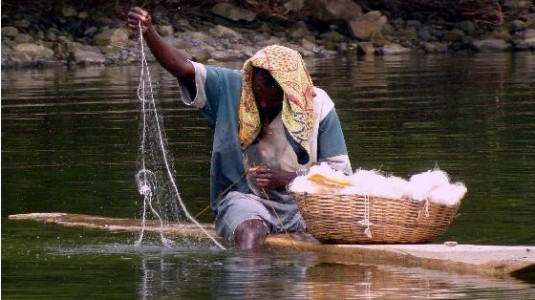
LAKE BOSOMTWE
I shall now
proceed to a more or less detailed account of this
lake, giving the results of investigations made on the
spot between the 1st and 14th of October 1921.
Bosomtwe is
a lake in Central Ashanti lying approximately in Lat. 60 30'
N., and Long. ro 25' E.
It is just
over five miles long and just under five miles broad.
It lies in a
perfect bowl.
Page 55
or cup, the
sides of which are thickly wooded hills rising about 500-700
feet above the lake, which I have been informed is itself
some 200 feet above sea level (vide Fig. I).
It has no
outlet, but there are many small streams flowing into it
from the mountain sides, and these, with the storm water
from the hill,slopes, form apparently its source, of supply.
Its general
appearance at once gives the layman the idea that its bed
was formerly the crater of a volcano.
The lake
shore is closely dotted with villages, of which there are
now twenty six.
There were
formerly thirty, but four have been submerged and not
rebuilt.
A fuller
account of these submerged villages will be given later.
The
previous sum total of our knowledge concerning this lake is,
I believe I am correct in stating, contained in an article
by Mr. Kitson, C.M.G., C.B.E., Goverment Geologist, a copy
of which is given in an appendix.
His short
geological report is most valuable and negatives the
phenomenon I shall describe presently being due to volcanic
causes.
Facing page 60
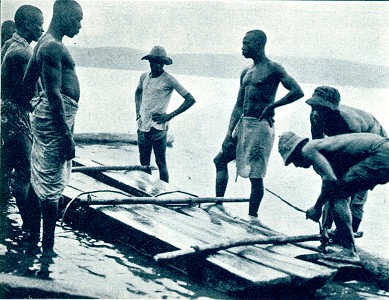 |
The making of the raft. |
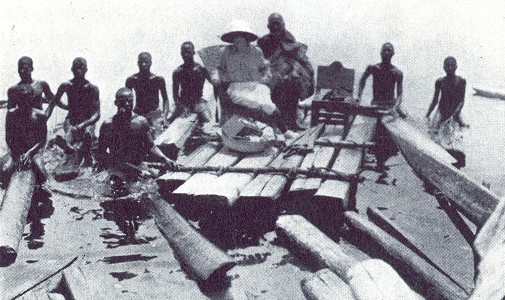 |
The raft at the landing-place at Abrodwum. |
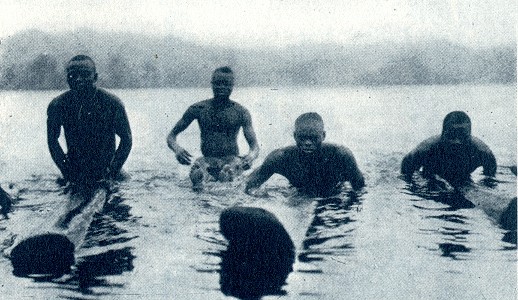 |
Showing various positions on mpadua. |
This
concludes alI I could discover concerning the myths,
traditions, and magic, religious aspect of the cult of this
lake,
which has-so
myth and tradition say-forbidden, and up to the present
forbidden with success, the use of any of the following
methods of catching fish, all equally 'hateful' to Twe, the
anthropomorphic lake god.
I. Iron
hooks of any description, or any kind of lure or line
fishing.
2. Asawu
(cast nets).
Page 62
3. Seine
nets.
4. The use
of canoes, boats, sails, paddles, poles, or any hollowing
out, even of a log.
5. Brass or
metal pans (only wooden ones must be used).
While the
following rules must also be observed:
6. No
fishing on Sunday. (1)
7. No
menstruating woman must go upon the lake.
Instead of
canoes, the lake-side dwellers go about on what each calls
his padua.
These are
logs with sides roughly hewn, as indicated in Figs. 6-9.
They are
made out of a very light wood almost as soft as cork called
odwuma fufuo, (2) and are anything from 6 ft. to 10
ft. long, about a foot wide, and 6 in. to 8 in. deep.
The ends of some padua are cut away at both extremities so as to offer less resistance than a blunt prow, and a few were seen in which these ends stood out of the water higher than the centre.
The
numerous photographs illustrating this chapter show more or
less clearly the different types.
Two or more
mpadua are lashed together to form an mpata,
or raft, and these are used to carry out the larger and
heavier nets to set up at the chosen fishing grounds.
Such a raft,
in process of construction and completed, is seen in Figs. 6
and 7.
No
cross-struts are placed underneath, those on top are
fastened by creepers, for rope may not be used, and such a
raft must only be propelled in the manner to be described
later.
It was upon
such a craft that my various expeditions upon the lake were
taken.
The
etymology of the word padua I have not been able to
trace with certainty.
Dua
is of course a log or a tree, and pa may be pa =
good; but if this be so we would expect the adjective to
follow the noun, and so have dua-pa.
Christaller
gives in his dictionary padua, a log or block of
wood in which the iron pa for securing the hand of a
prisoner is fixed, and also mpadua, a bedstead.
The latter
is possibly the same word, with the root mpa,
something to lie upon.
[Footnotes]
1. Even
should' the Lake explode its powder', on a Sunday no one
might touch the fish till Monday.
2. Corkwood
or Musanga Smithii.
For this and
other botanical names I am indebted to Major T. F. Chipp,
M.C., B.Sc., F.L.S., late Deputy Conservator of Forests,
Gold Coast, now Asst. Director at Kew.
Facing page 62
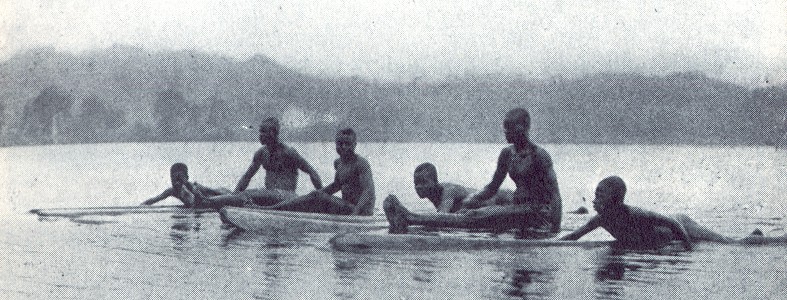 |
Showing various positions on mpadua. |
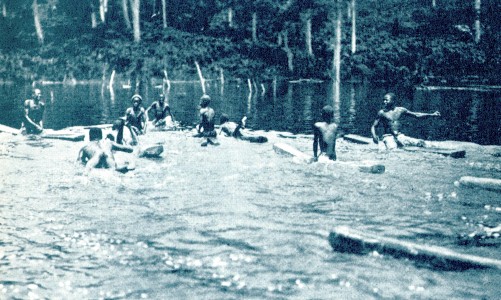 |
Villagers on mpadua turning out to meet our raft. |
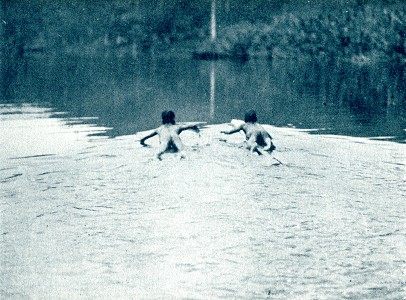 Fig. 11. Two young scouts dashing off to announce our arrival. |
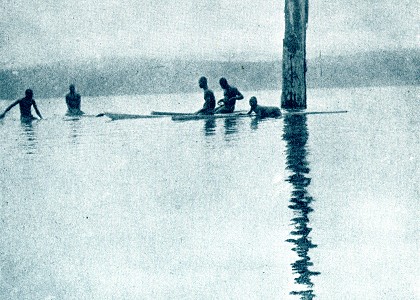 Fig. 12. On the lake: note the great tree top showing above the water. |
In spite of
the taboos forbidding the use of sail, paddle, oar, or pole,
the padua is propelled along the surface of the
water much faster than an ordinary canoe is paddled or poled
by one man.
The man on
the padua uses his hands as paddles, lying face down
on the log, when perfect steering control is obtained by a
flick of the foot upon the surface of the water.
The idiom
for to 'paddle' is yi abasa, lit. 'to =arm it '- 'to
throw out the arms '.
The various positions adopted on the padua will be understood from the photographs (Figs. 8-12).
The men are
very fine swimmers and some show magnificent muscular
development.
They swim
either the ordinary breast stroke or a double overarm with a
scissor-like kick of the legs.
My raft was pushed and drawn, and the endurance of the men was wonderful, for to swim while pushing a raft with two persons upon it for eight consecutive hours in a broiling sun is no small feat.
The 'pushers,' each on his own padua, kept the noses of their respective mpadua (or sometimes a foot) pressed against the stern of the raft, the' tractors' were in front lying flat on their mpadua with a piece of creeper tied round an ankle or sometimes simply held in the folds of the belly muscles, the other end being attached to the raft (see Figs. 13-14).
In Fig. 13
the small white object at the bow is a model padua
given me just before starting off, the rope is that used in
the sounding operation, to be described later.
This
photograph was taken about three miles from the north shore
on the return journey.
I did not
see any women on mpadua but was informed they were as expert
as the men, and this I quite believe, as I used to see whole
family parties alternately wading and swimming along the
lake shore instead of following the road running between the
villages.
Coming now
to the appliances used for fishing, these seem to be of four
kinds.
All are made
out of the same material, i. e. strips of the reed the
natives call sibire. (1)
All these
are really only slight variations of one simple design,
consisting of an oblong-shaped mat woven of simple
criss-cross pattern.
See
illustration on p. 64.
[Footnote]
1. A species of Clinogyne Scitamineae.
Facing page 64
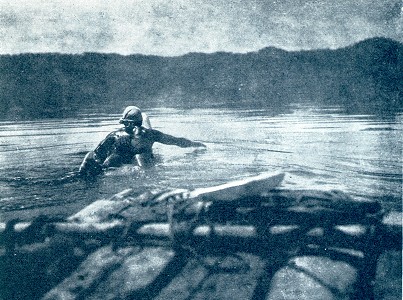 Fig. 13. Showing method of propelling the raft: a tractor. |
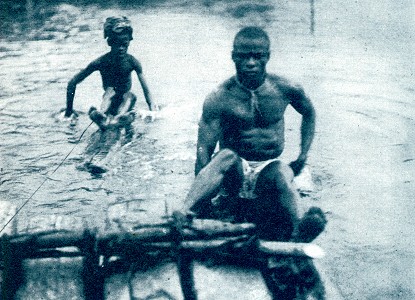 Fig. 14. Propelling the raft from the stern. |
None of
these traps or nets, it will be noted, are self-acting, i.
e. apart from the fisherman there is nothing to prevent the
fish swimming into the net and swimming out again.
There is,
however, another way of catching fish which is even more
primitive.
It is called
abontuo.
The
fisherman dives under the water, remains under from thirty
to forty seconds, and comes up holding a fish between his
teeth - to leave the hands free for swimming.
I think they
catch these fish possibly lying on the mud at the bottom,
and' tickle' them just as boys do in Scotland in the burns.
All fishing
methods give, the fishers say, but poor and small results in
comparison with the tremendous hauls of fish sent by the
lake spirit when' Bosomtwe explodes his gunpowder '.
Page 74
"There is
only one real lake in the country, and that is the sacred
Lake Bosumtwi in central Ashanti, about 18 miles south-east
of Coomassie.
This
freshwater lake is roughly circular in shape, with a
diameter of about 4 miles and an area of some 13 square
miles.
It lies in a
deep depression, with steep sides rising to 600 and 700 feet
above its surface.
Its depth is
unknown.
An attempt
was made to sound it by Mr. A. J. Philbrick, acting Chief
Commissioner of Ashanti, but unfortunately when 500 feet of
line had been let down it broke, and the attempt was
abandoned.
Though a
lake with no outlet and only a few small annual streams
flowing into it, the wateris fresh.
Its general
appearance suggests a volcanic origin viz. that it is a
caldera, but since no evidence whatever has been found on
its north-eastern and northern rim and shore of young
volcanic rocks, that view is hardly tenable.
The
available evidence suggests its formation as due to
subsidence.
Numbers of
villages stand on the shores of the lake.
There are
several interesting native beliefs about the lake.
It is sacred
to the Ashantis, who regard it as a great fetish.
They believe
that it is the seat of a powerful and energetic spirit which
manifests itself intermittently on its open surface by
flashing lights making noises like the discharge of
artillery, and in various other ways.
No canoes,
paddles, fish-hooks, or brass pans are allowed on or near
it.
Fish abound
in the lake, and are caught in an ingenious manner by the
natives.
Plaited reed
mats with gaping mouths are taken out from the shore by men
lying face downwards on cigar-shaped logs of wood. They
propel themselves by paddling with their hands, and having
set and anchored the nets, mouths open, the lower platform
just submeIged, they retire for some time.
The fish
enter the trap and bask in the subdued sunlight, resting on
the lower portion.
The
fishermen return almost noiselessly, pull together the two
parts of the trap, capture the fish and tow them and the
trap ashore."
- Extract
from a paper read by Mr. A. E. Kitson, C.B.E. before the
R.G.S., June 1916.
Page 322
I have had
occasion several times in the preceding chapters to mention
neoliths, which in Ashanti are known as God's axes or God's
hoes, and the following fuller notes upon them may be of
interest.
In the year
1911 it was my good fortune to be in Ashanti during the
latter part of the construction of the Coo- massie-Ejura
main trunk road, and to have obtained a collection of celts
which were then unearthed.
These formed
the subject of a most interesting paper by Mr. Henry
Balfour- (of the Pitt- Rivers Museum, Oxford) in the
'Journal of the African Society, (1) and I advise all who
are interested to consult that article.
In 1921 I
found myself again in Ashanti as Government Anthropologist.
In the short
time that has elapsed since taking up my new work some
hundred more specimens of celts have been obtained, a few
being found by me in situ, and many were dug up by the
Ashanti farmers, and one, the largest, was lately dredged up
from the bottom of the Offin River.
Some were
associated with the cult of the abosom, the suman, or of ,
Nyame.
While it is
correct to state that probably ninety-nine out of a hundred
Ashanti declare and actually believe that the stone celts
found by them emanate from the sky, and are in consequence
endowed with some of the power of the Sky God, Nyame,
sufficient evidence is available to prove beyond a doubt
that there are still alive in Ashanti to-day persons who
know that these stones are artifacts, and that they were
used by their ancestors at a period that was relatively
recent.
The ~har.ti
generally call them' Nyame akuma or 'Nyame asoso, i. e. the
Sky-God's axes or hoes.
They believe
that they fall from the sky during thunderstorms and bury
themselves in the earth.
They think
that, as they come from' Nyame, they are endowed with some
of the power of that great spirit, and this is the
explanation of their use in connexion with abosom and of
their
[Footnote] 1. No. XLV. Vol. XII, October 1912.
Page 323
supposed
potency as medicine.
As a
consequence of this belief they are constantly to be found
as appurtenances to abosom (the gods), suman (charms),
'Nyame dua (altar to the Sky God), or placed in a pot where
the drinking water is kept, .to cool the heart '. They are
also sometimes fastened against the body to cure diseases,
or are ground down and the powder drunk.
.I am
inclined to believe it is thought heterodox to say anything
contrary to the above, because these, being the popular
beliefs, are encouraged by the akomfo (priests), and that
some of the old people who really know better say nothing,
confess ignorance, or acquiesce in the generally accepted
opinion.
Nevertheless, I have been informed by several old men that, according to traditions handed down to therI:l, the so-called .God's axes' were really tools used by their ancestors in the past, not only previously to but contemporaneously with, a period when the smelting of iron was practised.
Kakari, an
exceptionally intelligent Ashanti, gave me the following
statement, before I was aware of the existence of the very
long celts here illustrated:
.My
grandfather, Kakari Panyin, once told me that he had been
told by his grandfather, who himself had heard of, but had
not seen them in use, that very very long ago the Ashanti
used the stone hoes which are now called' Nyame akuma. My
grand- father also told me our ancestors formerly wore a
girdle with leaves before and behind. He said these axes
were not originally the short things now found but were very
long, and that they used them for hoeing, holding them in
both their hands and digging between their open legs'
(translation from the ver. nacular). Kakari could not say
clearly whether they were hafted or not. He picked up a
stick lying 'against the verandah, to show the length, and
held it about If to 2 feet up the shaft.! Later, and after I
had seen the long celts (Figs. 41 and 142), another old man,
Kobina WUSU,2 between seventy and eighty years of age, told
me that his grandfather once told him that very long ago the
Ashanti used hoes made of stone a cubit long, demonstrating
this by holding out the right arm, fingers pointing, and
touching the elbow-joint with the left hand. When asked
1 A celt of
this length, from the Gold Coast, is now in the British
Museum. 2 His photograph may be seen in Fig. No. 41.
Page 324
why they
did not use iron, he replied that they also used it but that
it was scarcer and more difficult to work than stone, and
was only used for making nabuo (iron money). These
statements were made independently, and neither informer had
ever had any intercourse with Europeans, and neither had
been told by me the real origin of these celts. The points
of interest in these statements are:
I. The fact
that a definite tradition still survives of a stone age.
II. The
statement in each case that the celts were long (a foot or
more).
III. The
fact that in one case iron-working was stat~d to have been
practised contemporaneously with the use of stone.
It may be
here noted that the late Major Tremeane, in Nigeria,
also once
met an old native who knew the true origin of these'
celts. I
shall have more to say later as to the length of the celts.
It may be stated, however, that long celts have been
discovered; for example, one numbered I in Fig. 141 measures
24 centimetres. Long celts were apparently already known;
Mr. Balfour, in the article alluded to, speaks of .two long
slender celts from the Offin River', but does not give their
dimensions.
With regard
to iron currency, I had not before heard of nabuo or of an
iron currency in Ashanti. Moreover, the Ashanti do not now
work iron ore, nor are there any obvious traces of their
ever having done so.
In Chapter
IV, p. 47, of a rather rare old book entitled History of the
Gold Coast and Ashanti,l by a native pastor, the Rev. C. C.
Reindorf, in referring to Kwabia Amanfi, one of the earliest
Kings of Ashanti of whom tradition has any record, writes:
.All we know of him is that in his days gold was not known,
the currency was pieces of iron.'
The word
nabuo, used by the old Ashanti, is without doubt derived
from two words, dade, with a plural nnade, iron ore, and
buo, to pound or break up, and it describes the process by
which the laterite found in Ashanti was prepared for
smelting.
Ashanti
traditional lore seems to go back to this first King Kwabia
Amanfi. Reindorf gives his date very roughly as 1600,
1 Printed at
Ba..,le.
Page 325
and fifteen
Ashanti kings are recorded since then, ending with Prempeh,
who was exiled in 1896.
We thus have
some approximate data which would appear to point to the
fact that four hundred to five hundred years ago iron was so
little worked-1 do not say known-that it was used as
currency in Ashanti. If this be so, then we should expect
-an
overlapping of the Stone Age with the Iron Age until Euro-
pean iron was imported, and further interesting evidence
seems to confirm this supposition.
Before
passing on to this I may state that in Reindorf's History,
he also constantly alludes to the lost art of iron-smelting
in Ashanti, which, according to him, vanished when iron rods
began to be imported from Europe. These rods were apparently
at first used a-" currency, for he talks of 'the piece of an
iron bar which was the ordinary pay of a soldier '. I have
never seen any of this nabuo or iron currency, and there are
not any visible traces in Ashanti of iron furnaces, such as
may be seen in Togo- land.l There is, however, evidence that
iron was once worked.2
The town of
Obuasi in Ashanti is the centre of a large gold- mining
industry; it lies in a valley surrounded by isolated hills
which rise to a height of 500-600 feet from the plain below.
Many of these hills have been cleared of the dense forest
which formerly grew upon them, and are now occupied by
Government bungalows. There is neither outward sign n.Ql"
tradition of these having been the settlements of the
Ashanti in the past, but to judge by the remains under the
soil, they must have been the former sites of large
communities.
It is no
exaggeration to state that there is hardly a square foot of
ground on the tops of some of these hills which does not
contain fragments of pottery; and I was informed many celts
had also been found there. The pottery bears an endless
variety of designs, herring bone, bands, elliptical
punch-marks, contiguous and detached circles, &c. A celt
was also found by me about 6 inches below the surface (Fig.
140, no. 3). A few yards from it and in the same strata were
unearthed two curious objects of clay, one apparently
unbaked, the other having been
1 See' The
Iron Workers of Akpafu'. J. R. A. I., Vol. XLVI. 1916, by
R. S.
Rattray.
2 Since my
return to Africa two manilla were brought to me, they had
been dug up near Lake Bosomtwe.
Page 326
subjected to
intense heat (Fig. 14°, nos. I, 2, and 4). These seemed to
be fragments of a pipe, and reconstructed would have
..t.:-
this
appearance:
For some
time I could not obtain any explanation
: of these
objects; later, novkver, on my showing the collection of
pottery to an old Ashanti, he singled out these fragments at
once and said they were nsemua (sing. semua). He stated he
recognized
them as similar to one he had at home which had been handed
down by his ancestors. The semua, so he had~een told, was
used for smelting gold. The one in his possession was sent
for and
later presented to me. It was completely glazed and
encrusted
with a dark brown substance (Fig. 140, no. 4). The nsemua
found by me, the pottery and a celt, were all discovered on
the east side of the hill known as D. C.'s hill, and about
ten yards from the flat top upon which the bungalow I was
then living in was built. An examination of these nsemua,
(two found by me and one given to me) made in the Assay
Office of the Ashanti Gold-fields Corporation, gave the
following result:
.Semua. Both
samples which have been used show only
a trace of
gold.'
, One end of
the unbroken semua is encrusted with a dark brown substance
which corresponds to Ferrous Silicate.'
.This
material is only present at one end, the other end being
quite free.' ..
.An unused
semua shows on grinding that it is composed of unburnt clay
and sand intimately mixed.'
, There is
no room for doubt that the semua were tuyers used
in a native
blast furnace and that one specimen was that end which came
in contact with the molten slag.'
Mr.
Mervyn-Smith, the Acting Manager of the Ashanti Gold- fields
Corporation to whose courtesy and interest I am in- debted
for the assay of these specimens, also sent me a paper by J.
Morrow Campbell-read before a meeting of the Institute
NEOL~THIC
IMPLEMENTS IN ASHANTI 327
of Mining
and Metallurgy I-from which the following is an extract:
, In various
parts of the Gold Coast from the shores of the
N ani lagoon
to Ashanti are to be seen heaps of slag. No remains of
furnaces are to be found. ...
.They are
generally attributed to the Portuguese, but this is not
credible.'
Mr. Campbell
then proceeds to describe native blast furnaces in Haute
Guinee j he writes:
'. ..when
the walls have reached a height of 18 in., about
a dozen
irregular elliptical holes about I ft. long by over 6 in.
high are left at equal intervals. A large number of open
pipes or ,. Tuyers ", tapering from about 2 in. at one end
to over I in. at the other and over 1 in. in thickness,
composed of a mixture of clay an1i sand, are made and
thoroughly dried in the sun. They are inserted small end
downwards,' &c.
I think
enough has been said to indicate that those nsemua found
associated with a celt, are relics of an iron-smelting age
in Ashanti, and would seem to show that the Stone Age in
Ashanti survived into comparatively recent times and over-
lapped the Iron Age.
With
reference to the statements of those Ashanti, who say that
the stone hoes or axes were originally longer than those now
commo~ly known, I propose to consider some specimens I have
at present available, with a view to seeing if this is a
reasonable supposition. An examination of any collection of
West African celts-I have about a hundred before me as I
write, not including the photographs of forty-one more in
the article by Mr. Balfour, to which reference has been
made-will show that they fall into one or other of the
following groups (see p. 328).
I. Short
celts with ground edges and tapering butt (A).
2. Short
celts with ground edges, the butt as wide, or nearly so, as
the cutting edge (B).
3. Short
celts in all stages intermediate between these two.
4.
Cylindrical stones with both ends blunt (no cutting-edge)
(c). 5. Cones (D).
6. Very long
celts tapering towards the butt (rare) (E) (see p. 329). Let
us now take any of the longer celts shown in Fig. 141,
1 No. 67.
4th April 1910.
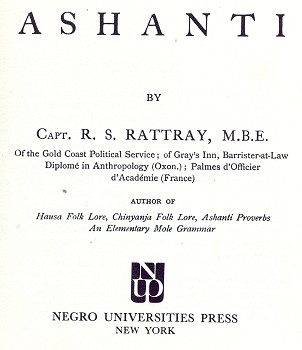 |
Ashanti Negro Universities Press, New York,1969.. [cropped] |

| home | catalogue | history | references | appendix |